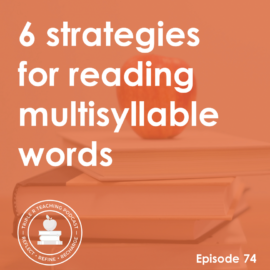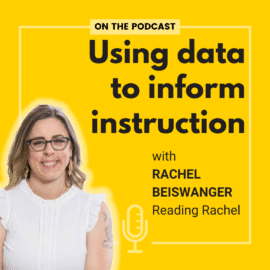
TRT Podcast#67: Do’s and don’ts for teaching phonics
Should we teach letter sounds before letter names? Do kids need to learn syllable division rules? We’ll examine it all in this episode, the first in our new series about teaching phonics.
Listen to the episode here
Full episode transcript
Hello, Anna Geiger here from The Measured Mom. Welcome to Triple R Teaching and today we're kicking off a podcast series all about teaching phonics. Today, we're going to look at The Do's and Don'ts for Teaching Phonics.
Number one: DO teach phonics in a systematic explicit way. Now, if you're like me and do a lot of reading about the science of reading and structured literacy, you've heard this way too many times to count, but it's so important that we're going to put it front and center!
To teach phonics in a systematic way, we want to make sure we have a quality scope and sequence that we follow. Now, usually this is going to come with a phonics program that you're using. If you're not using a program or you have some freedom in your scope and sequence, you can certainly head to my website and get my free scope and sequence, which I'll link to in the show notes.
When you choose a scope and sequence, you want to make sure that it progresses from simple to more complex. Typically, that's CVC words, then words with blends and digraphs, then possibly CVCE words, vowel teams, and r-controlled vowels. Some of those are a little switched around in some programs and that's okay, but we want to make sure that in general, we're going from simple to more complex. We also want to make sure that we don't put concepts that are easily confused right next to each other.
There are a few other things to think about when you're choosing a scope and sequence, and I have a blog post all about what order to teach phonics skills. I'll link to that as well.
The other part of this is DO teach phonics in an explicit way.
So when I was a balanced literacy teacher, I definitely believed that I was teaching phonics, and I was, but it was very much an embedded approach. It was to teach phonics as it comes up. I would mention things when we were doing shared reading, I would point out maybe a vowel team or something else when a child was "reading" leveled books. But I didn't have a specific phonics block every day where I taught from a scope and sequence.
Now with that said, DON'T teach ONLY phonics. The goal of reading is reading comprehension. If you can picture the Simple View of Reading in your mind, you know that decoding - sometimes referred to as word recognition - times language comprehension equals reading comprehension. So the language comprehension piece is very important. If students can sound out words in a decodable book or another type of text, but they can't tell you what they just read, reading comprehension is not occurring.
A common criticism of the science of reading is that people who promote it are only about phonics. Now of course we know that's not true, but we have to be careful in our practices to make sure that people understand that we know it's not true. So you want to make sure you build time into your daily schedule for vocabulary and comprehension building. I recommend doing that through quality read alouds that you have every day in kindergarten, first, and second grade.
I think that those read alouds should do three things. They should build knowledge, they should build vocabulary, and it's an opportunity for you to teach comprehension skills and strategies. But don't forget, the key things that they should be doing are building knowledge and vocabulary.
Our next do is DO teach letter names and sounds. I'm a little hesitant to say this one, because this tends to be a big blow-up discussion in any circles where people are passionate about teaching young children. There is a debate about whether you should teach just the sounds, or letter names first, or both at the same time.
I just can't get on board with this idea that we should only teach letter sounds to beginning readers. It's not like you can block out the rest of their life, where people are going to be talking to them about letter names.
I don't think there's anything wrong with teaching both at the same time. One thing to remember is that a lot of letter sounds are embedded in a letter's name, right? As in the letters "f," "v," the letter "d," and so on. They're not in every one, but in many, so it's not as hard to learn letter sounds as you might think.
On the other hand, one thing that people who promote letter sounds first are advocating for is a way to get students to grasp the alphabetic principle sooner. The alphabetic principle is understanding that this letter on the page represents a sound, and I'm completely on board with that.
We do have to remember that when kids learn letter names, that's not enough. That's not going to get them reading. So it's really best to teach letter sounds with letter names, unless you're teaching, let's say a two year old who maybe isn't ready to learn that, but can memorize names of letters.
I also want to address something many people, myself included, point out that the research shows us that letter-name knowledge and phonemic awareness are some of the key indicators for later literacy achievement. So if kids are good at those two things, they will likely have success in reading. But I think we have to be careful to remember that it's not knowing letter names itself that leads them to be successful.
I recently read an article called Phonics Faux Pas by Nell Duke and Heidi Mesmer, who are both really good people to read when it comes to understanding the research. In their article, they point out that while it's true,
"It is not because letter-name knowledge is an even-close-to-sufficient contributor to actual reading or writing. It is helpful, but some children learn to read knowing only letter sounds — no letter names. The predictive power of letter names lies largely in the fact that it is a proxy for other things. Children who know letter names early are more likely to have experienced a substantial emphasis on print literacy in the home and to have attended a strong preschool, for example, which in turn increase the likelihood of higher later reading and writing achievement."
So, in other words, what they're saying is if a child knows their letters early, they're probably in a strong literacy environment, and a lot of other things are happening that will lead to them being successful in reading.
My next don't is DON'T forget about the alphabetic principle. That same article that I was referencing earlier has a really good analogy. So let me read that to you. It says,
"Imagine going to work for a shipbuilding company. You go to work the first day and are schooled in all the different types of bolts, screws, and nails. You learn their names, the different sizes, and the different types, but you never learn that their purpose is to join pieces of metal and that those pieces of metal are used to build ships! Although this situation is clearly ridiculous, it is actually analogous to what we see in some prekindergarten and kindergarten classrooms. Children are being taught to name letters or even identify the sounds that the letters represent, but they are unclear about why they are learning it. Letter-sound knowledge is being learned in a vacuum; the child has no context for how to use the information, no 'big picture.'"
Now there are a lot of ways to build the alphabetic principle. That should probably be a whole podcast episode by itself. But one of my favorite ways to do this is to integrate letters with phonemic awareness instruction, even if students maybe don't know all the sounds of all the letters.
So let's say you have a picture of a sun on a page, and then you have three blanks, one for each letter. You help kids separate that word into its three phonemes - /s/, /ŭ/, /n/. Then on each line you put a magnetic letter, or a letter tile, or you write the letter that represents the sound.
So you say, "What's the first sound of the word 'sun?' /s/. What letter represents that sound? 's'. Can you write an 's' on this line, or put a letter tile there if they're not quite ready to write. Even preschool children can learn phonemic awareness with letters. So that's a good way to build the alphabetic principle.
Moving on, the next one is two-part. DO teach specific generalizations. DON'T get bogged down in rules.
Now this is very controversial, and I want you to know that I'm not opposed to phonics rules, I'm actually becoming certified in Orton-Gillingham, which is pretty heavy on phonics rules. I just think we need to be careful. I think we need to definitely teach generalizations, including things like every syllable should have a vowel, that there are different types of syllables. I do think we should teach the six or seven syllable types, like open, closed, r-controlled, CVCE, and so on. It's helpful to know that when "w" comes before "or," the "or" represents the sound /er/. It's good to know that a digraph is two letters that represent one sound. It's just that if we go on and on and on and on and on, down the rabbit hole of rules, we could get to quite a lot.
I think the rules are important for reading, but particularly for spelling. I think some people don't want to teach the rules because they think that's not necessary for kids learning to read. And maybe it's not, but having those rules in their back pocket is going to come in really handy when they're spelling.
I don't think we want to get down the rabbit hole of kids having to recite rule, after rule, after rule. I think you should teach it, show them how to apply it, provide an anchor chart, but I wouldn't want to waste a lot of class time with having kids articulate rules. And that's what I mean by not getting bogged down by the rules.
Remember the point of the rules, it's to help children decode and encode, which is spell. Recitation of long lists of rules is not going to help them with decoding and encoding. It's going to take up class time.
DO teach strategies for reading and spelling multi-syllable words. This is another big area of controversy in the science of reading world, where some people would believe that you should teach the syllable types and you should teach syllable division rules. There are others that say, this is all a waste of time and what we really want to focus on is getting kids actually reading, not dividing words into syllables.
Many people would say that instead of teaching syllable types, specifically, you can teach an alternate way of sounding out or spelling these long words, using some general principles. "Readsters" has a really interesting YouTube video about this. I can't remember all the steps, but basically you have kids count the vowels. And by count the vowels, you'll have to teach them that a vowel team would count as one and the silent e doesn't necessarily count and so on, but you're going to teach them to count the vowels. Then that will tell them how many syllables and then they can draw blanks for each syllable and then break the word up. So there is still a process but it's not so rule-based.
I would say that either of these things can work as long as you teach one. Kids need some kind of strategy for handling multi-syllable words and they need practice finding those chunks.
Our next don't is DON'T make all your phonics lessons be whole class lessons. If you're familiar with the science of reading, you probably have heard of Nancy Young's Ladder of Reading and Writing. She went through the research and basically found which percentages of students are more likely to learn to read without a structured approach, and which need a structured approach, and so on. Basically what she found is that MOST students will benefit from a structured approach, and a few can read without a lot of explicit instruction - a very small percent.
In an article that I read recently called "Differentiation: The Key to Serving ALL Students Climbing the Ladder of Reading," she expresses concern that she's seeing many teachers not differentiating. The teachers have done a positive thing, which is have a new appreciation for helping students who struggle, but they're not really interested in challenging the kids who don't need as much explicit instruction.
That's why I think small group teaching for phonics is so important. If you've been teaching for ten minutes, you know that the students in your class come to you with a vast variety of skills when it comes to reading. So if you teach kindergarten, you're going to have some kids who don't know their letters, and you may have a child or two or more who's already reading when they come into kindergarten. They don't need the same lessons.
So I think it's really important to give a good quality phonics assessment. Again, I will provide a link to one of mine in the show notes. Then after you look at that assessment, you group students by need. So if they need to learn letter sounds, they should be grouped together. If they're advanced readers and they're learning to read multi-syllable words, they should be in a group. By doing that, you can meet the needs of everyone versus just a small section of your class.
This episode could go on for hours, but I'm going to close it now with a final do and don't: DO educate yourself, but DON'T get stuck in the weeds.
By that I mean, learn as much as you can about phonics, there is so much to learn and it's actually super interesting, believe it or not. There's so much to learn about different approaches to teaching phonics, and different ways to incorporate phonemic awareness. There are different things to learn about why some words are spelled the way they are, different ways to divide words into syllables, and to attack multi-syllable words. There's a lot to learn about word roots and word meanings.
There's just so much to phonics, but we don't want to get stuck in the weeds and feel paralyzed. Sometimes you see these discussions going on in science of reading Facebook groups, which are really interesting, but a lot of times there's someone that seems to say that everything you've been doing is wrong and that you have to teach phonics this one particular way.
What you need to remember is that you need to be systematic and explicit in the way that you teach phonics. And you can certainly learn and grow all the time and you should be, but don't let someone else's opinion slow you down. Experiment, try new things, but know that as long as you're being systematic and explicit with your phonics instruction and including language building with quality read alouds, you are going to be doing a great job.
So stick with me because we're going to be sharing more tips and resources for teaching phonics in the next few weeks. And you can check the show notes by visiting themeasuredmom.com/episode67. Remember to check out my membership, The Measured Mom Plus, which has loads of resources for teaching phonics and other aspects of literacy and math. Learn more at themeasuredmom.com/membership. We'll talk to you again next week.
Sign up to receive email updates
Enter your name and email address below and I'll send you periodic updates about the podcast.
Related resources
- What order should you teach phonics skills? Blog post
- Scope and sequence for teaching phonics skills
- Phonics Faux Pas, by Nell K. Duke & Heidi Anne E. Mesmer
- Differentiation: The Key to Serving ALL Students Climbing the Ladder of Reading, by Nancy Young
- Multi-Syllable Words Made Easy (with Readsters’ Linda Farrell) on YouTube








Mary Riley
I love your site and I really enjoyed reading this. Is there a printable version and where can I get the reading/phonics scope and sequence? Thank you.